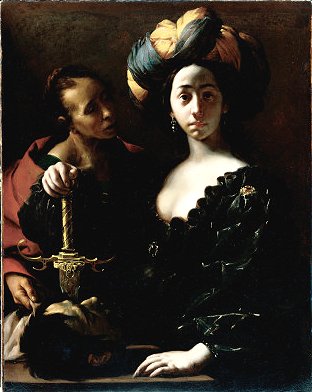 |
|
JUDITH HOLDING THE
HEAD OF HOLOFERNES
by Francesco del
Cairo
Italian, 1607-1664; SN 798, oil on canvas
By Allan Miller.
February 29, 2000
APPEARANCE:
- Composition
– A young woman, staring at us. She is
wearing a turban and holding a sword. On the table in front of her is the severed head of
a man. Emerging from the shadows in the background is an older woman who is holding a
sack. The figures are crowded into a small space forcing them close to one another and to
us.
- Light
and color – All the light in the painting comes from a single source. Combined with
the dark background and dark costumes this light creates a strong contrast which focuses
the viewer’s attention to certain parts of the painting. The light falls strongly on
the woman’s face and chest, on her hands and her turban, and more weakly on her
sword, the severed head and the older woman.
|
Personalities –
The young woman’s costume, her turban, her rich robes with a revealing neckline,
gives her the exotic appearance of a temptress. The objects around her, the severed head
and the sword, indicate a gruesome, violent event. What is she doing? Is she shy and
retiring? Is she hysterical, having lost her composure? No, she is confrontational! What
about her expression? Is it cold and impassive? Shocked? Is it unapologetic and
unrepentant? Or is she regretful? A little of each maybe? Does she show a comfort with her
act, but a regret for its necessity? How many people have experienced a sense of drained
anticlimax after a dreadful experience? Clearly, the older woman is concerned, inquiring,
even curious. Has she glimpsed something in
the young woman which is unexpected, something of a revelation? What words or thoughts
would you put into the mouths or minds of the subjects?
SUBJECT:
- Title:
Judith with the Head of Holofernes.
- Judith
was a young Jewish widow who saved her village from the Assyrians. She dressed in her
finest robes and approached the enemy camp as a defector. Having retired to the tent of
the Assyrian general, she proceeded to get him drunk and to cut off his head with his own
sword.
- The
moment captured by the artist shows Judith confronting the viewer with the proof of her
extraordinary act, as her maid is about to place the head in a sack so she and Judith can
slip back to their village with their tale of conquest.
PAINTER AND
HISTORICAL CONTEXT:
- Francesco
del Cairo was born in 1607 in Milan where he painted his earliest works. Many of the
artists active in Milan at that time created eerie, macabre works with subjects involving
sex and violence.
- In
1633 he was called to Turin to become court painter to the powerful Duke of Savoy. This is the beginning of a life long association
with the House of Savoy, which brought del Cairo an extensive reputation as well as great
social and financial rewards. Some authorities believe del Cairo may have left Milan for
Turin to escape a charge of murder, although this is not a universally accepted opinion.
His best works were all
done during the early part of career, before the age of 35, after which he lost much of
his originality, adopting the styles of other painters or movements
- An
inventory of del Cairo’s property upon his death, lists paintings by many of the
greatest painters of his time (including Rubens, van Dyke, Salvator Rosa and Guido Reni),
raising the possibility that during his later life del Cairo was a dealer as well as an
artist.
- Painted
around the time of the artist’s arrival in Turin, this painting is undoubtedly one of
his greatest works. Its theme and size are typical of the works he was doing for private
collectors of the time. Its dramatic use of
color, lighting and composition, and its subtle expression of emotion are masterful.
|
